Customer experience (CX) is crucial for your business success. It encapsulates how customers perceive your brand based on every interaction they have with you. From pre-purchase inquiries to post-purchase support, every touchpoint plays a vital role in shaping their overall experience. If you want to improve CX, understanding customer pain points and leveraging opportunities for enhancement can lead to increased satisfaction and loyalty.
In today’s competitive market, implementing an effective CX strategy has become essential. You need to align your processes with customer needs and expectations. By taking a holistic approach, you ensure that every interaction adds value, which is vital for retaining customers and fostering long-term relationships. Companies focusing on their CX strategy often witness business growth, correlating satisfied customers with increased sales.
To create a winning customer experience, adopting best practices is paramount. These include personalized communication, timely support, and easy access to information. By leveraging technology like customer relationship management (CRM) systems and omnichannel platforms, you can provide seamless interactions across multiple channels. Consistency in your messaging builds trust, elevating overall customer experience.
Understanding Customer Experience: A Comprehensive Overview
Your understanding of customer experience can significantly impact your business. The right CX strategy is not just about aesthetics; it aligns your processes with customer expectations. For instance, the fictitious company, Clinic HealthPlus, revamped its CX strategy after realizing that patients often struggled to schedule online appointments. They implemented a user-friendly online booking system, resulting in a 25% increase in patient scheduling and a 15% reduction in appointment no-shows.
Additionally, analyzing customer feedback is essential. By collecting data regularly, you not only gauge satisfaction levels but also identify areas for improvement. For instance, the Transportadora MegaLogística saw a 30% increase in customer satisfaction ratings after restructuring their feedback mechanism. Implementing changes based on this feedback created a responsive environment that adapted to customers’ needs, turning challenges into opportunities.
Personalization vs. Generic Interaction: A Crucial Comparison
Personalization in customer experience is no longer optional. While generic interactions may serve a purpose, they often fail to engage customers effectively. Compare the approach of e-commerce giant, ShopSmart, which employs advanced data analytics for personalized product recommendations, with a traditional retailer that offers a one-size-fits-all service. ShopSmart experienced a 20% increase in repeat purchases simply by tailoring offers, while the traditional retailer struggled to maintain customer interest.
Leading organizations understand that successful CX hinges on the specifics of each customer interaction. A personal touch can foster loyalty, increase conversion rates, and ultimately drive revenue growth, as demonstrated by the increased engagement metrics seen by brands embracing tailored strategies.
The Importance of Customer Experience in Business Growth
The significance of CX in driving business growth cannot be overstated. Companies prioritizing their CX strategy often outperform competitors. For example, the luxury pet care chain, Pet Pamper, experienced a 40% increase in sales annually after revamping their customer experience. By investing in employee training and streamlining processes, they transformed customer interactions into memorable experiences.
Moreover, mapping customer journeys affords insights into pain points. By understanding these pathways, businesses can optimize the overall CX. The fictitious company, TechWiz, successfully used this method to identify bottlenecks in their online service processes. After implementing changes, they saw a 50% decrease in customer complaints related to service delays.
Omnichannel Support vs. Single-Channel Communication: What Works?
Consider the differences between omnichannel support and single-channel communication. Omnichannel approaches allow seamless transitions between platforms. A case in point is FunEvents, a ticketing platform that integrated chat, email, and phone support. They increased customer satisfaction by 35% after creating a cohesive experience across channels, compared to companies using isolated communication methods.
By understanding your customers’ needs, you solidify loyalty and ultimately drive sales growth. Establishing an omnichannel strategy equips you with the tools to cater to customer preferences efficiently and effectively.
Best Practices for Enhancing Customer Experience
To enhance customer experience, adopting best practices is vital. Start by fostering a customer-centric culture. This involves empowering employees to prioritize customer needs. The fictitious company, Home Comforts, recently implemented this strategy through collaborative cross-department workshops. As a result, they increased customer satisfaction scores by 25%.
Incorporating technology into your strategy is equally important. Utilizing CRM systems enables you to maintain meaningful connections. For example, the online retailer, FashionHaven, utilized CRM analytics to track customer interactions, resulting in a 15% reduction in response times, which in turn boosted customer retention rates.
Feedback Collection vs. Ignoring Input: A Fundamental Difference
Feedback loops form the backbone of effective CX strategies. Regularly soliciting customer feedback allows you to identify areas for enhancement. Companies like the fictitious restaurant, Gourmet Kitchen, which actively engaged with customer reviews, improved their menu offerings based on patron preferences, leading to a 30% uptick in repeat customers.
In contrast, businesses that ignore feedback risk stagnation, as evidenced by companies that fail to adapt their offerings based on consumer insight.
Measuring Customer Experience: Metrics and Tools
For effective enhancement of customer experience, measuring it is essential. Metrics give you insights into satisfaction levels, loyalty, and overall experience. Net Promoter Score (NPS), for example, helps gauge customer loyalty by asking how likely they are to recommend your brand.
Consider Sarah’s Bookstore, which utilized NPS and CSAT scores to track customer feedback. By consistently monitoring these metrics, they improved their customer service training programs, yielding a 27% increase in positive feedback over six months.
Surveys vs. Metrics Monitoring: What’s More Effective?
Survey-based feedback collection often contrasts with real-time metrics monitoring. While surveys provide direct insights, continuously tracking metrics like CES allows companies such as Online Solutions to remain proactive. After analyzing their CES scores, they redesigned their checkout process, resulting in a 20% decrease in cart abandonment rates over just three months.
This proactive approach can lead to significant gains in customer satisfaction and retention rates.
Creating a Customer-Centric Culture within Your Organization
Establishing a customer-centric culture is essential. Every employee, from management to frontline staff, should understand their role in prioritizing customer needs. Take, for instance, the fictitious company, Relax Spa, which initiated a comprehensive training program focused on empathy and engagement. They reported a 35% increase in customer loyalty as a direct result.
Moreover, utilizing feedback to shape practices can create a responsive culture. For example, after implementing customer surveys, the software company, CodeCraft, adapted its project timelines based on customer input, resulting in a noticeable drop in customer complaints—by 30% over six months.
Top-down Leadership vs. Bottom-up Initiatives in CX Culture
The contrast between top-down leadership initiatives and bottom-up culture building can significantly affect organizational effectiveness. Leaders at the fictitious brand, GreenLight Technologies, embraced a bottom-up approach, leading to innovative customer service strategies. This resulted in a remarkable 50% increase in customer satisfaction ratings, illustrating the effectiveness of grassroots initiatives in fostering a customer-focused culture.
Conclusion: Elevating Customer Experience for Sustainable Business Success
Elevating customer experience is fundamental for sustainable business success. By focusing on implementing effective CX strategies, businesses can exceed customer expectations and foster loyalty. For instance, BrandsUnited, a fictitious company, aligned its processes with customer preferences and saw an impressive 40% growth in customer referrals.
Creating a robust customer experience involves understanding pain points and leveraging technology for seamless interactions. Businesses like Nexloo, which offers an omnichannel support platform, exemplify this strategy by creating consistent, integrated customer experiences, enhancing satisfaction and driving growth.
By prioritizing a culture centered around customer needs, investing in employee training, and continuously measuring success, businesses can adapt effectively to market changes. This agile mindset will not only keep your business relevant but enhance your competitive edge.
Learn more about how to optimize your omnichannel experience at Nexloo.









